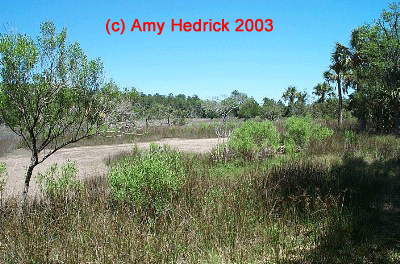|
Myers Plantation
Myers Plantation is 180-Acre Heritage
(by Deborah Doub, news staff writer; The Brunswick News)
This article was written in the 1970s,
Mr. Drawdy and Dony Middleton have since passed away. The pictures are
Amy Lyn Hedrick's.
This is a transcription of a news
article, the text and language belong to the author, Deobrah Doub.
 Myers Plantation is an 180-acre tract
stretching across the piney wood, sporadic chasms of fields and meadows, edging
toward the apertures of the marshlands and waterways.
Myers Plantation is an 180-acre tract
stretching across the piney wood, sporadic chasms of fields and meadows, edging
toward the apertures of the marshlands and waterways.
It is one of the more tranquil, unhurried spots on earth, far
removed from the mechanisms of the busy city of Brunswick, only a few miles
away, almost a place disregarded by time and progress.
Living here, the descendant of the first owners of the
plantation, enjoys the timelessness and beauty of the land, harvesting crops
there, raising livestock, and every November cutting the cane crop and grinding
it in the 100-year old mill to make cane-syrup.
Joe Drawdy and his wife Vivian are proud of the land and they
cherish its history, preserve the original land deeds for property granted by
King George III of England.
They attach sentimentality to an ancient buckeye bush which
Drawdy recalls has been growing on the land since before Civil War times. In stories handed down to him by his mother and her forbearers, Drawdy relates
how bricks and salt were made by the slaves on the plantation grounds, and takes
special pride in walking into a nearby wood to point to the tomb of his great
grandfather and great grandmother.
He knows every inch of the plantation, which has in recent
times seen dispersion among relatives to such an extent that Drawdy and his
brother were obliged to go to Hawaii and California to buy back most of the
original 180 acres.
The property is located off of Hwy. 82 west, near the Wizawee
[really called Vis-a-vis] Islands and the oldest church in Glynn County, Emmanuel
Methodist Church.
Drawdy said he has no records of all the forbearers who once
lived and worked this land, but recalls that his grandfather and great
grandfather were both named George.
He laughs when, in telling how the land has been bartered and
bought back throughout the 150 years of his family's occupation, he relates how
is granddaddy George Myers swapped a yoke of oxen for the Wizawee Islands.
Drawdy never knew his grandfather, but remembers hearing his
mother say the George Myers was 50 years old before he married and had five
children.
"My grandmother was Lizzie Cooper of Charlton County. When his parents were old and sick, my grandfather went looking for a nurse to
take care of them...that nurse was my grandmother whom he married at the age of
50 after his parents died."
A mound of red clay interspersed with whole and broken
hand-molded brick is situated near a creek bed in the woods on the property.
Drawdy says this is the spot where bricks were molded and
fired by the slaves a hundred years ago. He said these bricks are quite
similar to the brick he uncovers in his demolition work on Bay St. and other
historic Brunswick areas.
"I have an idea that brick made on the plantation was loaded
up on the plantation and shipped to Brunswick to help build it when it was a new
city," said Drawdy.
A clearing near the modern brick home Joe and his wife have
just recently built is the spot where the first two plantation houses stood.
The first was a
two-story frame structure and the second a one-story frame dwelling. Drawdy said his mother, Dora Myers, recalled the
first house was "there in slavery times" and burned, and that the second house
burned down when his mother was a little girl.
"They were only able to save some clothing," he said.
Drawdy's mother, blind with glaucoma for almost 30 years,
lived to be 84 and handed down to her five children and three grandchildren she
reared legends and facts concerning the plantation and their ancestors.
Near the location of the original houses is a sugar cane
mill, forged before the Civil War and still in use today.
Every November it is a tradition to cut the can and grind it
in the mill, then boil it down into syrup. The Drawdy's invite people from all over the area to the event and send them home
with bottles of syrup sealed with cork and wax.
Drawdy's invite people from all over the area to the event and send them home
with bottles of syrup sealed with cork and wax.
In the shed there the sugar is boiled to make a syrup in the
sugar trough hewn from a solid cypress tree 100 years ago.
The boiling pot originally used during the mid-nineteenth
century has not been moved from its location near the marshland in over a
century.
Drawdy pointed to a fresh water pond, long since dammed and
filled with bass, as the location of what was formerly salt water creek.
Here the workers cleaned their clothing with use of "washing
shelves" and "batting blocks".
A few yards away is another pond fed by a spring which
supplied the plantation with water for 150 years.
Walking further into the nearby wood, Drawdy showed the
remains of three vaults. All made from red clay brick molded and fired on
the plantation.
The vaults, now crumbling and filled with earth, once
contained the bodies of his great grandfather George C. Myers and his great
grandmother whom he recalls was Isabella Dodge.
The slave cemetery is located a few yards away, and sunken
areas and mounds, a single slab, and a marker over a child's grave serve as
reminders of the families of indentured servants bound to the Myers family.
The woods have thickened now over the area where the cabins
of the five slave families once stood. Each family was given 20 acres.
A descendant of one of the last slave families at the
plantation, Aunt Donie Mitchell, still lives near the Myers family property.
"Aunt" Donie lives in a 27 year old house on what she
lovingly refers to as "the old home place" where she grew into womanhood.
The present house is situated in a clearing in the piney
woods on the Pickney tract, just northeast of the plantation property.
Aunt Donie, who claims she is 89, is reputed to be "around
100" by neighbors and relatives. Her husband, Dan Middleton, died in 1961.
"My mother always used to tell us children that she was 6
years old when the slaves were freed", said Aunt Donie, who recounted that her
mother, Lucy Mitchell, was reared on the Tison plantation by Miss Erin Tison.
Donie Mitchell Middleton's grandparents were Joe and
Phoebe
Pinckney. They had 11 children: Richard, Anick, Sam,
Frank, George,
Lucy, Clarissa, Mariann, and Lizzie.
Lucy Mitchell born at Bethel married a preacher, the
Rev.
Simon B. Mitchell, himself born and reared at Fish Hall Plantation.
Donie's grandparents worked the land, planting and raising
crops like corn, okra, peas, rice, and potatoes.
Donie, one of 14 children, said she was born at Brookman in
1885. She taught school for 45 years, attended Albany State College and
taught in Camden, Ware, and Glynn Counties.
The Joe Drawdys have in their possession several deeds which
give insight into the acquisition of the Myers Plantation.
According to information gained from researching survey maps,
deeds, and conveyances housed in the Glynn County Courthouse, and from "English
Crown Grants in the Parishes of St. David, St. Patrick, St. Thomas, and St. Mary
in Georgia, 1755-1775," it appears the Myers family came by the property which
is now the plantation in the early 1800s.
Joe Drawdy said that George and Latson Myers were the German
immigrants who first settled in Glynn County and acquired the land here, but
there is no mention of these brothers in the land grant survey for the aforesaid
parishes.
Latson Myers is mentioned, however, in documents in the
Drawdy's possession, namely in 1866 and 1872.
The oldest document held by the Drawdy's, who keep all their
valuable papers in a safe in a vaulted room, is an indenture between Thomas
Elliott Law, a planter from Liberty County, and two note-worthies from Glynn
County's past, planters and plantation owners John Couper and James Hamilton.
Law, who had been formerly married to Margaret Carney,
daughter of colonial landowner Arthur Carney, became legal heir to the 150 acres
he later sold to Couper and Hamilton.
Arthur Carney, a landowner mentioned frequently in the state
archives publication concerning land grants in St. David's parish, owned land
that later became the Myers property.
The indenture paper between Law, Couper, and Hamilton, dated
17 July 1804, begins: "Whereas George the Third King of Great Britain and
by his certain grant, the great seal of the then provence of Georgia, bearing
the first day of November 1775, granting a tract of land in St. David's
Parish..."
Arthur Carney is later mentioned in another deed involving
another of Joe Drawdy's forbearers, James Myers.
In 1830, after the death of James Hamilton, James Myers was
involved in a transaction between Hamilton's heirs and himself for the
conveyance of 385 acres in the Hopewell tract.
Myers paid $1000 for the tract, part of the property on the
south side of the Turtle River known as the Hopewell Tract.
The Hopewell property was divided into five tracts:
Arthur Carney's 1850 acre tract; adjoined by 250 acres granted by the King to
John Duncan on 2 July 1771; and tracts owned by Peter Massie and
Zachariah
Timmons.
The deed was signed in the presence of John Couper, Jr. and
entered into the Glynn County records in 1831.
One of the earliest mentions of a Myers in Glynn County
records is that of Mary "Meyers" in 1799. Through the years, the "e" after
the "m" in the surname is omitted, with the name evolving to its present
spelling, Myers.
Mrs. Meyers, the widow of William Meyers, bought a negro
slave named Marcus for $300 from Leighton Wilson.
In another conveyance dated 18 January 1828, James Myers
received from Cela (should be Celia) Lamb as his "part of the estate of
Frederick Lamb, the negro slaves Peggy, age 16, and August, age four."
James Myers is again mentioned in a business transaction with
Joe Drawdy's grandfather, George C. Myers, in 1866. This conveyance
concerns land bounded on the north by the Turtle River and on the east by Butler
Creek, on the south by land owned by Latson Myers and W.A. Tallons land, and on
the west by Bonaventure tract and land owned by John P. Scarlett. Also
sold were 40 head of stock cattle branded with the letter "M".
Another transaction between the two occurred in November of
1866 when George C. Myers bought 174 acres.
Also, in the collection of old documents owned by the Drawdys
is a map drawn by surveyor George Purvis, dated 1 July 1802, showing Turtle
River, Butler's Creek, and Black Rush Creek. There is also a paper between
John and Elizabeth Butler of Chatham County and Thomas Armstrong, this dated 4
February 1806.
See
Myers Cemetery for some of
the burials.
|

